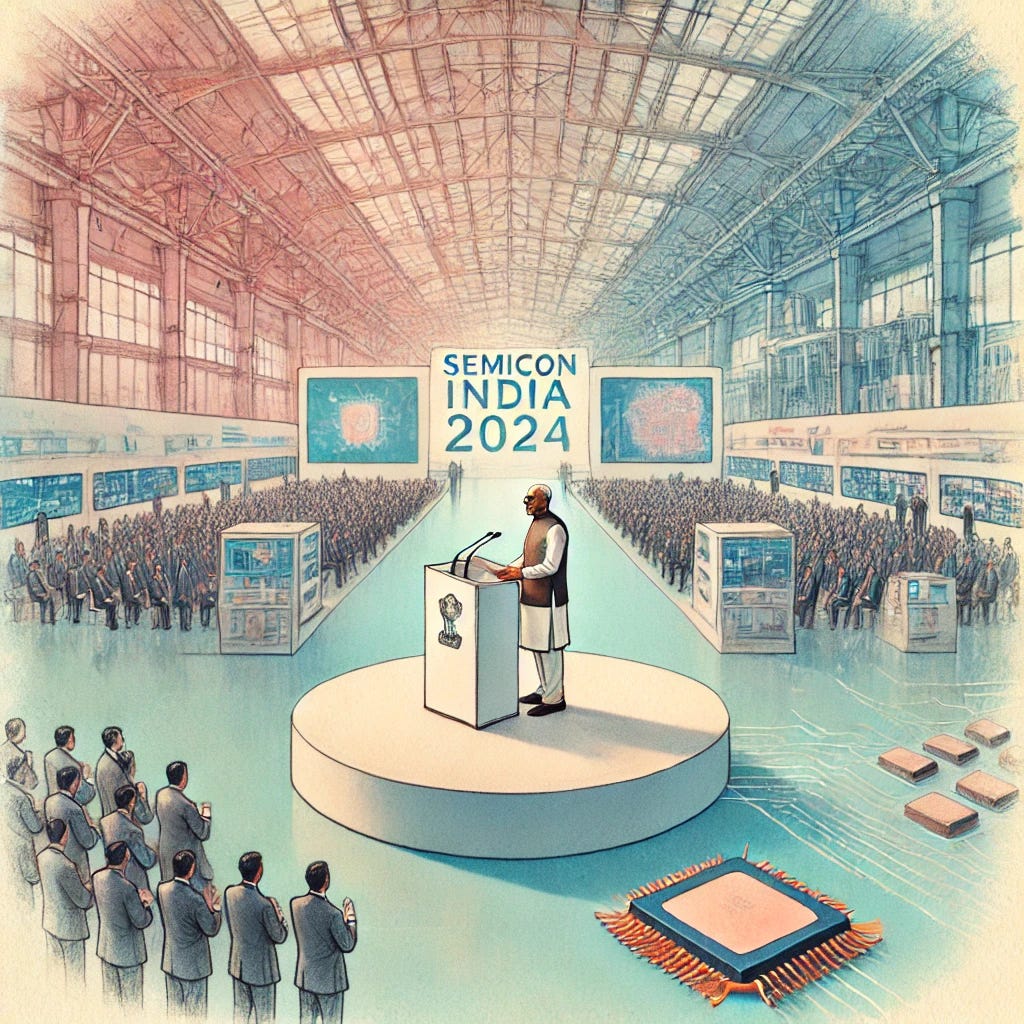India’s Semiconductor Revolution: PM Modi Inaugurates SEMICON India 2024 in Greater Noida
PM Modi Inaugurates SEMICON India 2024 in Greater Noida
India’s Leap into the Global Semiconductor Arena
India is on the cusp of a technological revolution, driven by a burgeoning semiconductor industry. On 11th September 2024, Prime Minister Shri Narendra Modi inaugurated SEMICON India 2024 at the India Expo Mart in Greater Noida, Uttar Pradesh, in the National Capital Region (NCR), marking a pivotal moment in India’s bid to become a global semiconductor hub. As India positions itself at the heart of the global semiconductor supply chain, this event serves as a testimony to the country’s strides in technology, manufacturing, and a farsighted dynamic policy reform.
India’s Strategic Focus on Semiconductor Manufacturing
During his address, PM Modi highlighted the significance of the semiconductor industry as a key driver of India's future growth. He drew a metaphorical comparison to diodes, stating that India's semiconductor sector is equipped with "special diodes where energy flows in both directions," symbolising the mutual collaboration between industries and government, backed by stable policies and an ease of doing business environment. With a semiconductor workforce set to grow by 85,000 professionals, India is rapidly preparing its youth to meet the demands of this high-tech sector.
Three-Dimensional Power: Reforms, Manufacturing, and Aspirational Market
PM Modi underlined India’s "three-dimensional power" – a reformist government, an expanding manufacturing base, and an aspirational market. This triad, unique to India, is fostering an integrated semiconductor ecosystem. By aligning policy, infrastructure, and the consumer market, the Indian government aims to make the country not just a consumer but also a leading producer of semiconductors. These initiatives reflect India's commitment to self-reliance (Aatmanirbhar Bharat) and its ambition to play a critical role in the global supply chain.
India’s Ambition: From Consumer to Global Player in Semiconductors
The Prime Minister envisioned a future where “every device in the world will have an Indian-made chip.” India’s rapid progress, driven by governmental incentives and global partnerships, is evident in its ability to attract over ₹1.5 trillion in investments in a short span. The SEMICON India Program, which provides financial backing for front-end fabs, packaging, and the semiconductor supply chain, is a critical component of this strategy. Furthermore, India's burgeoning tech society, along with innovations in digital infrastructure like UPI and Digi Yatra, have been pivotal in ensuring last-mile connectivity for millions of citizens.
The Role of International Collaboration: Silicon Diplomacy
India’s semiconductor ambition is further strengthened by its international collaborations. PM Modi spoke of moving from "Oil Diplomacy" to "Silicon Diplomacy." As a key partner in initiatives like the QUAD Semiconductor Supply Chain and the Indo-Pacific Economic Framework’s Supply Chain Council, India is playing a pivotal role in ensuring supply chain resilience in a post-pandemic world. Bilateral agreements with nations like Japan, Singapore, and the US bolster India’s strategic position in the semiconductor domain.
GPU and AI Chip Development: India’s Next Technological Frontier
As part of India’s broader push into high-tech sectors, the government is already making significant investments in GPU and AI chip infrastructure. With plans to provide GPU-based computing resources under the India AI Mission, the country aims to accelerate AI-driven innovation. This initiative will make 10,000+ GPUs available to startups and researchers, empowering India’s tech entrepreneurs to innovate at a global scale. Partnerships with companies like NVIDIA are expected to further strengthen India’s GPU and AI chip capabilities, critical for next-generation technologies.
Key Projects and Investments: Building India’s Semiconductor Ecosystem
Several key semiconductor projects are underway across India, furthering the nation’s technological ambitions. The Tata-Powerchip Semiconductor Manufacturing Facility in Assam, with an investment of ₹91,000 crore, is set to produce 50,000 wafers per month. Meanwhile, Micron Technology's assembly and test facility in Gujarat and Tata Electronics' OSAT facility are poised to bolster India’s semiconductor manufacturing capabilities. These initiatives are complemented by investments in design and packaging, which form integral parts of the semiconductor value chain.
India’s Bold Vision: 100% Electronics Manufacturing in India
A key highlight of PM Modi's address was the ambitious goal of ensuring that 100% of electronics manufacturing takes place within India. With the electronics sector already valued at $150 billion, the government’s target is to increase this to $500 billion by 2030, creating 6 million jobs in the process. This growth, in turn, will fuel the domestic semiconductor industry, ensuring that India not only designs and assembles chips but also manufactures finished electronic products.
India's Semiconductor Policy: Comprehensive Support for Innovation
The government’s support for the semiconductor industry is evident through its Production Linked Incentive (PLI) scheme and the Design Linked Incentive (DLI) scheme. These policies aim to boost both large-scale manufacturing and innovation in chip design. More than ₹130 crore has already been committed to Indian startups developing cutting-edge ICs for telecom and AI applications. This robust policy framework is crucial in driving domestic and foreign investments into India’s semiconductor ecosystem.
Securing Critical Minerals for the Future
Recognising the importance of raw materials in semiconductor manufacturing, PM Modi outlined the recently launched Critical Mineral Mission. By focusing on securing and producing critical minerals domestically, India is aiming to reduce its dependence on external sources. The government’s initiatives in customs duty exemptions and mining auctions are designed to ensure a steady supply of essential minerals for semiconductor production.
Conclusion: A Future Shaped by Indian Innovation
India’s semiconductor journey is a bold and transformative step towards becoming a global technology powerhouse. With robust governmental support, growing international partnerships, and a focus on innovation, India is well on its way to realising its vision of a self-reliant semiconductor ecosystem. As PM Modi aptly remarked, “When the chips are down, you can bet on India.” This optimism is supported by a strong foundation of policy, infrastructure, and talent, ensuring that India plays a pivotal role in shaping the future of the global semiconductor industry.





